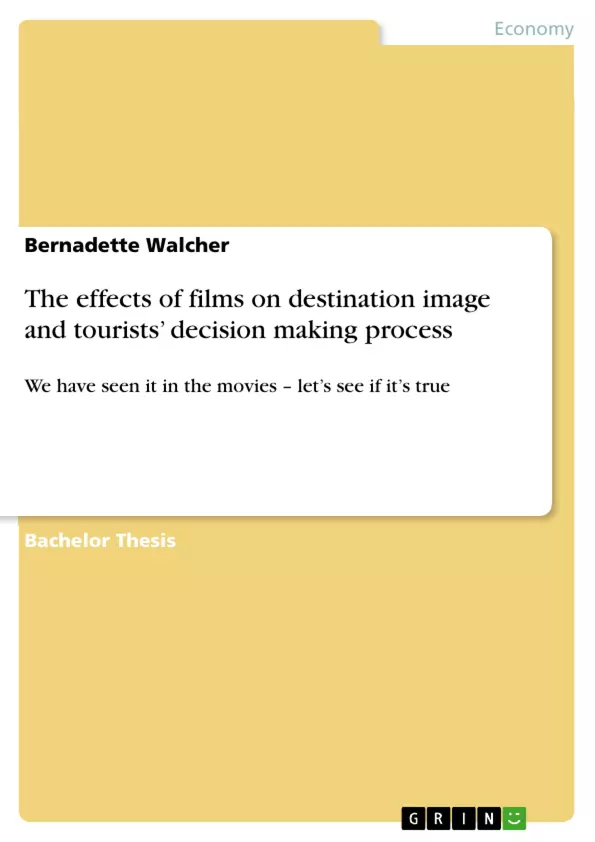Homo Sapiens is the story telling animal and for more than 100 years, it is film, more than any other medium, which has taken us on journeys on which we are temporarily drawn into a fictional story. Although the main purpose of a film is not to persuade the audience to travel to a certain place presented in a movie, location placement may stimulate the travel demand. Due to intangibility a main characteristic of services tourists are often faced with uncertainty during their decision making process. Tourism researchers provided empirical proof that movies and television series may help to reduce perceived risks, enhance familiarity and lead to a favourable image formation in consumers’ minds.
Epic story telling can be seen as a main characteristic that unites the film and tourism industry, which both make a living from creating experiences. Within the latter destination image is of paramount importance because it fundamentally affects tourists’ decision making process in which emotions play an essential role. Films and television series are said to communicate emotions and viewers often identify themselves with the stories and places depicted in the movie. Movies can be seen as an effective marketing tool that can lead to high market penetration without the “hard sell” impressions of usual promotional activities. Furthermore films serve as cultural ambassadors that present the uniqueness of a place. Therefore tourism organisations often go into partnership with the film industry and agree to host film crews in order to leverage the effects of film-induced tourism
Inhaltsverzeichnis (Table of Contents)
- Main Part
- Introduction
- Status quo
- Findings
- Research gap
- Research objective
- Structure
- Core section
- Film tourism a literature review
- Introduction to film-induced tourism
- Film-induced tourism - an interdisciplinary area
- Definitions and forms of film tourism
- Film tourists and their travel motivations
- Location placement
- Destination image literature review
- Definitions of destination image
- Formation of destination image
- Factors that influence destination image
- Dimensions of a destination image
- The multisensory image as a component of destination image
- Conclusion
- Tourists' decision making process
- The complexity of tourist decision making process
- Consumer behaviour
- The AIDA model
- The Visitor Journey
- Customer journey
- The impact of destination image on tourists' decision making process
- Films' influences on destination image and on tourists' decision making process
- Between dreams and reality - what unites the film industry and tourism
- Conceptual framework on viewers' response to films and television series
- Location placement and destination image
- Epic storytelling - film tourism success factors
- Best practice example of film induced tourism
- Visit Britain
- James Bond goes Austria
- The Sound of Music - Austria's cultural ambassador
- Bollywood new comers on the fast track
- Conclusion and limitations
- The impact of films on destination image formation.
- The role of film tourism in shaping tourist perceptions and travel choices.
- The influence of destination image on tourists' decision-making process.
- The application of storytelling techniques in destination branding.
- Best practice examples of film-induced tourism initiatives.
Zielsetzung und Themenschwerpunkte (Objectives and Key Themes)
This study aims to analyze the effects of films on destination image and tourists' destination selection. It explores how films can influence individual perceptions of a destination, ultimately affecting their travel decisions. The work delves into the relationship between film tourism, destination image formation, and the consumer decision-making process.
Zusammenfassung der Kapitel (Chapter Summaries)
The introduction provides a background on the role of storytelling in human perception, emphasizing the importance of visual media and the impact of globalisation on destination image. The study highlights the significance of destination image in tourism and the role of film as a tool for branding.
The core section delves into a literature review of film tourism, examining its definition, forms, and motivations of film tourists. It then explores the concept of destination image, defining its formation, influencing factors, and dimensions. The chapter analyzes the decision-making process of tourists, examining the complexity of their choices, consumer behavior, and the influence of destination image.
The study further investigates the influence of films on destination image and tourists' decision-making processes. It explores how films can bridge the gap between dreams and reality, presenting a conceptual framework for understanding viewers' responses to films and television series. The chapter discusses the impact of location placement and storytelling on film tourism success.
The research concludes by presenting best practice examples of film-induced tourism, including Visit Britain, James Bond tourism in Austria, The Sound of Music in Austria, and the rise of Bollywood tourism.
Schlüsselwörter (Keywords)
This study focuses on key concepts like film tourism, destination image, tourists' decision-making process, location placement, film-induced tourism initiatives, storytelling, and destination branding.
- Quote paper
- Bernadette Walcher (Author), 2016, The effects of films on destination image and tourists’ decision making process, Munich, GRIN Verlag, https://www.grin.com/document/343311



